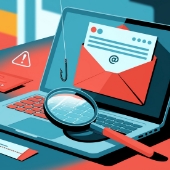 A new security flaw in Microsoft 365 enables hackers to exploit office devices and send fake emails that appear to be from within an organization. Let’s look at how this scam works and what you can do to keep your data protected.
A new security flaw in Microsoft 365 enables hackers to exploit office devices and send fake emails that appear to be from within an organization. Let’s look at how this scam works and what you can do to keep your data protected.
How do hackers use office devices to send fake phishing emails?
Microsoft 365’s Direct Send feature was originally designed to simplify internal email communication within organizations. However, hackers have discovered a way to use it to send phishing messages that appear to have come from within the company, all without ever accessing a single email account.
Because these messages are disguised as internal communications, they can easily bypass security filters that typically block suspicious messages. Also, these emails often mimic normal document alerts or voicemail notifications, so they appear trustworthy to employees. Since employees are used to receiving such emails, they are more likely to open them without hesitation. Once a link is clicked or an attachment is opened, hackers can steal personal information, capture login credentials, or install harmful software on your network.
Why office devices are the perfect tool for cybercriminals
While printers and other office devices are often used in handling documents with sensitive information, they are often overlooked in security plans, creating a vulnerability that hackers are eager to exploit. Without robust security measures in place, printers, scanners, and smart office equipment can become gateways for phishing schemes and other malicious activities.
Tips to protect your business against phishing
Safeguarding your organization requires integrating all office devices into your cybersecurity strategy. This means ensuring they are regularly updated, securely configured, and continuously monitored for potential vulnerabilities. You can start with the following steps:
- Check your email settings: Make sure your email system is equipped with robust security measures to guard against fraudulent emails, including tools that verify authentication and detect spoofing.
- Consider all devices equally important: Keep an eye on printers, scanners, and other network-connected devices, as they are potential targets for hackers. Patch security updates as soon as they become available, and observe printers, scanners, and fax machines for any unusual beeping, flashing lights, or printing.
- Train your employees: Train your staff to identify suspicious emails, particularly those that appear to come from within the company. Additionally, make it mandatory to double-check any email that asks for sensitive information.
- Monitor email activity: Watch out for unusual email activity, such as messages being sent from strange devices or to unusual places. Setting up alerts for abnormal behaviors can help catch issues early.
The bottom line: Staying proactive and vigilant is key
Cybercriminals will try to take advantage of any potential access point to your system. A good rule to remember is that if a device is connected to your network, it is automatically a potential weakness.
For more help with securing your organization against phishing attacks and other cybersecurity threats, reach out to our IT team today.



